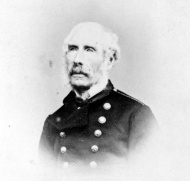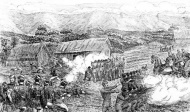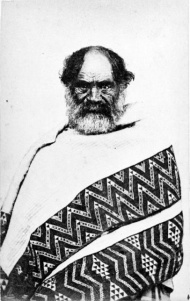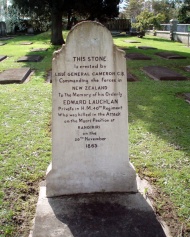Events In History
-
 5 May 1898Dog Tax War narrowly averted
5 May 1898Dog Tax War narrowly avertedThe dramatic events of this day were the climax of widespread Māori opposition to the colony-wide introduction of dog registration from 1881 Read more...
-
 19 February 1883Release of Parihaka leaders Te Whiti and Tohu
19 February 1883Release of Parihaka leaders Te Whiti and TohuParihaka had become the symbol of opposition to the government policy of land confiscation in the aftermath of the New Zealand Wars. Te Whiti o Rongomai and Tohu Kākahi were imprisoned without trial after the military occupation of the south Taranaki community in November 1881. Read more...
-
 24 February 1870Last imperial troops leave New Zealand
24 February 1870Last imperial troops leave New ZealandThe final detachment of the 18th (Royal Irish) Regiment left New Zealand, leaving the Armed Constabulary (formed in 1867) responsible for the colony's internal defence. Read more...
-
 6 May 1869Colonial troops invade the Urewera
6 May 1869Colonial troops invade the UreweraThe invasion of the Urewera was intended to punish Tūhoe for supporting Te Kooti Rikirangi, whose ‘rebel’ force it had sheltered after its defeat at Ngatapa, inland from Poverty Bay, in January. Read more...
-
 13 February 1869Killings at Pukearuhe
13 February 1869Killings at PukearuheA Ngāti Maniapoto war party sacked the redoubt at Pukearuhe (White Cliffs), northern Taranaki, killing military settlers and family members. Later that day, the missionary John Whiteley also fell victim. Read more...
-
 10 November 1868Te Kooti attacks Matawhero
10 November 1868Te Kooti attacks MatawheroTe Kooti and his supporters attacked Matawhero in Poverty Bay, killing approximately 60 people – roughly equal numbers of Māori and Pākehā. Read more...
-
 7 September 1868Von Tempsky killed at Te Ngutu-o-te-manu
7 September 1868Von Tempsky killed at Te Ngutu-o-te-manuGustavus von Tempsky was killed during an assault on Tītokowaru's south Taranaki pā. His exploits during the New Zealand Wars had made the Prussian soldier of fortune a folk hero for many European settlers. Read more...
-
 30 April 1864Pai Mārire defeated at Sentry Hill, Taranaki
30 April 1864Pai Mārire defeated at Sentry Hill, TaranakiIn one of their first military efforts, several hundred Pai Mārire warriors attacked a British redoubt at Te Mōrere (Sentry Hill) in Taranaki. Scores were killed and wounded. Read more...
-
 29 April 1864Assault on Gate Pā
29 April 1864Assault on Gate PāWith substantial artillery and 1700 men, the British assaulted the Ngāi Te Rangi stronghold of Pukehinahina (Gate Pā), which was defended by just 230 warriors. Read more...
-
 6 April 1864Pai Mārire ambush in Taranaki
6 April 1864Pai Mārire ambush in TaranakiA British patrol was ambushed by Pai Mārire warriors near Ōakura. The heads of the seven men killed were taken around the North Island by Pai Mārire disciples to encourage enlistment in the movement. Read more...
-
 31 March 1864Rewi's last stand?
31 March 1864Rewi's last stand?The last battle of the Waikato War began when the spearhead of a 1200-strong British force charged an apparently weak Māori position at Ōrākau, south-east of Te Awamutu. Read more...
-
 21 November 1863Māori surrender at Rangiriri
21 November 1863Māori surrender at RangiririMore British soldiers were killed at 'Bloody Rangiriri' than in any other battle of the New Zealand Wars. But their victory opened the Waikato basin to the imperial forces. Read more...
-
 17 July 1863Māori force defeated at Koheroa
17 July 1863Māori force defeated at KoheroaThe British invasion force led by Lieutenant-General Duncan Cameron had its first significant encounter with Waikato Māori at Koheroa, near Mercer. Read more...
-
 12 July 1863British forces invade Waikato
12 July 1863British forces invade WaikatoLieutenant-General Cameron's force crossed the Mangatawhiri stream. This was the first act of war in the Waikato campaign, which had been planned in part to gain land for European settlement. Read more...
-
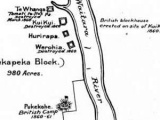 17 March 1860First Taranaki War erupts at Waitara
17 March 1860First Taranaki War erupts at WaitaraThe opening shots of the first Taranaki War were fired when British troops attacked a pā built by the Te Āti Awa chief Te Rangitāke at Te Kohia, Waitara. Read more...
-
 16 May 1846Eight killed in attack on Boulcott Farm
16 May 1846Eight killed in attack on Boulcott FarmSix soldiers were killed and two more Europeans were mortally wounded when Ngāti Haua-te-rangi leader Te Mamaku attacked the British post at Boulcott's Farm in Hutt Valley. Read more...
-
 17 June 1843The Wairau incident
17 June 1843The Wairau incidentAlso known as the ‘Wairau Affray’ and ‘Wairau Massacre’, this was the first serious clash of arms between Māori and British settlers after the signing of the Treaty of Waitangi. Four Māori and 22 Europeans were killed. Read more...
Articles
Māori King movement - 1860-94

King Tāwhiao's reign was dominated by the Waikato War and its fallout.
-
Page 2 – Build up to war
Like his father, King Tāwhiao opposed the war in Taranaki. The government, however, remained unconvinced. In July 1860 Governor Gore Browne sought to isolate the Kīngitanga and
-
Page 3 – Response to war
The invasion of the Waikato united the various factions within the Kīngitanga, and during the war Kīngitanga forces had some victories despite being overwhelmed in terms of
New Zealand's 19th-century wars

War changed the face of New Zealand in the 19th century. Tens of thousands of Māori died in the intertribal Musket Wars from the 1810s to the 1830s. There were fewer deaths during the New Zealand Wars (1840s-1870s) between Māori and the Crown, but the consequences were still dire for many tribes.
-
Page 3 – Taranaki and Waikato wars
An overview of the conflict between Māori and European settlers in Taranaki and Waikato during the New Zealand Wars.
-
Page 4 – Prophets and colonists
From 1864, a new round of fighting in the New Zealand Wars was sparked by Māori religious movements.
-
Page 5 – End of the New Zealand Wars
The New Zealand Wars ended in 1872. European settlers prevailed through weight of numbers and economic power. By 1900, New Zealand was a settler society, with Māori pushed out
-
Page 6 – Timeline
Timeline of key events related to the Musket and New Zealand Wars, 1800s-1910s
-
Page 7 – The Victoria Cross and the NZ Wars
There were 15 recipients of the Victoria Cross and 23 of the New Zealand Cross for action during New Zealand’s 19th-century wars.
-
Page 8 – NZ Wars flags
For many Maori in the 19th century, the Union Jack was frequently viewed as a potent symbol of Great Britain's power in New Zealand. In the New Zealand Wars, Maori parties who
-
Page 9 – Further information
Recommended links and books relating to New Zealand's 19th-century wars
Pai Marire

Pai Marire (goodness and peace) was one of several Maori Christian faiths to emerge in the 19th century. Like many others, it was closely tied to issues of land and politics.
-
Page 2 – Te Ua Haumēne
Pai Marire disciples travelled around the North Island in the mid-1860s. Against a backdrop of war and land confiscations, the founding principle of Pai Marire was often
-
Page 3 – The death of Carl Völkner
The ritual killing by Pai Mārire followers of missionary Carl Völkner in 1865 shocked many people. The government used the event as a reason to take harsh action against Pai
War in Wellington

In 1846 fighting broke out in the Wellington region as the Ngāti Toa chief Te Rangihaeata backed local Maori opposed to European settlement in the Hutt Valley. The campaign claimed few lives and Ngāti Toa resistance in the region was effectively ended as a result.
-
Page 2 – The Port Nicholson purchase
In September 1839 William Wakefield, the principal agent for the New Zealand Company, met Te Ātiawa chiefs Te Puni and Te Wharepōuri at Pito-one (Petone), on the northern shore
War in Whanganui

The confusion and uncertainty that had surrounded the New Zealand Company's land purchases in Whanganui erupted into violence in the autumn and winter of 1847. The conflict here also involved longstanding rivalries between upper and lower Whanganui River Māori.
-
Page 2 – Background
From the outset there was confusion and uncertainty over the exact nature and extent of the New Zealand Company's purchase at Whanganui.
-
Page 3 – The Matarawa killings
The killing of Mary Gilfillan and three of her children caused tension between upriver and downriver Māori as well as among Europeans.
-
Page 4 – The siege of Whanganui
Te Mamaku led 700 Ngāti Hāua-te-rangi warriors who attacked Whanganui in May 1847.
-
Page 5 – Moutoa Island
The Pai Mārire religion divided Māori. Some supported it, but others mistrusted its political intent. Events on the Whanganui River in 1864 showed the conflict about the faith
-
Page 6 – The 1865 campaign
Following the battle of Moutoa Island in 1864, Hipango pursued the retreating Pai Mārire (Hauhau) warriors. Fighting continued from fortified positions upriver near Hiruhārama
War in Taranaki 1860-63

In March 1860 war broke out between Europeans and Māori in Taranaki following a dispute over the sale of land at Waitara. It was the beginning of a series of conflicts that would dog Taranaki for the next 21 years, claiming the lives of several hundred Maori and Europeans and leaving deep scars that persist to the present day.
-
Page 2 – Pressure on Māori land
As the non-Māori population of New Zealand grew during the 1850s, Māori faced more pressure to sell their land to these new settlers.
-
Page 3 – The Waitara offer
Wiremu Kingi's opposition to the Crown's attempts to purchase land near the mouth of the Waitara River in north Taranaki in 1859 led to the outbreak of war in March 1860
-
Page 4 – Fighting begins
The opening shots of the Taranaki war were fired at Kīngi's new pā, Te Kohia – also known as the ‘L’ pa because of its shape – on 17 March 1860.
-
Page 5 – Puketakauere
On 27 June 1860 the British suffered a heavy defeat near Waitara. The Te Atiawa chief Hapurona had strengthened defences on the twin pa sites of Puketakauere and Onukukaitara,
-
Page 6 – A change in tactics
The arrival in August 1860 of Major-General Thomas Pratt heralded the development of a new strategy to break the cordon that encircled New Plymouth.
-
Page 7 – Stalemate
After a year of war, Governor Gore Browne still saw little likelihood of victory in the near future. A truce was arranged on 18 March 1861.
-
Page 8 – The second Taranaki war
On 12 March 1863, 300 men of the 57th Regiment evicted Maori from the land they had occupied at Tataraimaka, 20 km south-west of New Plymouth.
-
Page 9 – Further information
Links and books for further reading about the Taranaki wars
New Zealand Wars memorials

There are more than 60 memorials in New Zealand to the dead of the New Zealand Wars. But their story is strikingly different to that of the memorials put up in memory of those who died in the country’s other major conflicts
- Page 1 - New Zealand Wars memorialsThere are more than 60 memorials in New Zealand to the dead of the New Zealand Wars. But their story is strikingly different to that of the memorials put up in memory of those who
War in Waikato

After fighting broke out again in Taranaki in early 1863, Governor George Grey turned his attention to the region he saw as the root of his problems with Māori: Waikato. This was the heartland of the anti-landselling King Movement (Kīngitanga). Grey vowed to ‘dig around’ the Kīngitanga until it fell.
-
Page 2 – Invasion plans
Governor Gore Browne demanded that the Kīngitanga submit ‘without reserve’ to the British Queen and began planning an invasion of Waikato shortly before his reassignment to
-
Page 3 – The opening phase
The British invasion of Waikato began on 12 July 1863. The first line of defence was at Meremere. After this was bypassed, Rangiriri and Pāterangi provided a second and then a
-
Page 4 – Rangiriri
The decisive battle for Waikato was fought at Rangiriri in November 1863.
-
Page 5 – The invasion continues
After the British victory at Rangiriri, Wiremu Tāmihana tried to negotiate peace. He sent his greenstone mere (club) to Cameron as a token of his good faith. But neither Grey
-
Page 6 – The Battle of Ōrākau
James Belich argues that the British victory at Ōrākau was also their ‘cruellest disappointment of the entire war.’ Chris Pugsley, on the other hand, sees Ōrākau as the ‘
War in Tauranga

During the first half of 1864 the focus of the New Zealand Wars shifted from Waikato to Tauranga. In this phase of the conflict British forces suffered a catastrophic defeat at Pukehinahina – better known as the Gate pā – but later inflicted heavy losses on Māori forces at Te Ranga.
-
Page 2 – Invitation to war
The Ngāi Te Rangi leader Rāwiri Puhirake had resisted Wiremu Tāmihana’s request for help during the war in Waikato for fear that this would lead to bloodshed in Tauranga. The
-
Page 3 – Gate Pā
Gate Pā was a major disaster for the British military who suffered twice the casualties of the Māori defenders
-
Page 4 – British soul searching
British soul-searching after the defeat at Gate Pā did not begin with an acknowledgement of the superior tactics and capability of their enemy.
-
Page 5 – Te Ranga
Unlike at Gate Pā, where the British assault had been concentrated at two points, at Te Ranga the British were able to attack all along the line of trenches.
-
Page 6 – The fighting ends
By the end of July the Tauranga war was over. Most Ngāi Te Rangi warriors accepted peace and handed over weapons, although many of these were old and of such poor quality as to
-
Page 7 – Further information
Links and further reading about the war in Tauranga
Te Kooti's war

Te Kooti was one of the most significant Māori leaders of the 19th century. For nearly four years he waged a guerrilla war unlike any previous conflict in the New Zealand Wars. His influence continues to be felt in the eastern Bay of Plenty and East Coast, where his Ringatū faith remains strong.
-
Page 2 – Clashes of faith
A civil war erupted on the East Coast in the winter of 1865 when Hauhau evangelists ignored a warning not to enter Ngāti Porou territory.
-
Page 3 – Exile and deliverance
Chatham Island would be home for Te Kooti and his fellow prisoners for two years from 1866.
-
Page 4 – Te Kooti's war begins
In July 1868 Major Reginald Biggs sent three Māori emissaries to Whareongaonga. Te Kooti and his followers were told to surrender all their weapons and ‘await the decision of
-
Page 5 – Matawhero
Shortly before midnight on 9 November 1868 Te Kooti and around 100 men moved on Matawhero. By dawn nearly 60 people from Matawhero and the adjacent kāinga had been killed.
-
Page 6 – Ngātapa
An attack by a combined Ngāti Porou-government force saw Te Kooti retreat inland to the ancient hilltop pā of Ngātapa.
-
Page 7 – Te Kooti goes to Te Kūiti
Te Kooti was invited to the King Country only if he came in peace. He responded defiantly that he was coming to ‘assume himself the supreme authority which he coming direct
-
Page 8 – Te Pōrere and retreat
On 25 September Te Kooti was defeated by a combined force of Ngāti Kahungunu, Te Arawa and Ngāti Tūwharetoa at Te Ponanga, near Tokaanu.
-
Page 9 – A Māori matter
Te Kooti's final decades
-
Page 10 – Further information
Links and books relating to Te Kooti's war
Tītokowaru's war

In the 1980s James Belich argued that Tītokowaru’s war had become a ‘dark secret’ of New Zealand history, ‘forgotten by the Pākehā as a child forgets a nightmare’. For Belich, Tītokowaru was ‘arguably the best general New Zealand has ever produced’.
-
Page 2 – Early years
Tītokowaru’s commitment to missionary Christianity was showing signs of strain by the 1850s as a Māori nationalist movement emerged.
-
Page 3 – The year of the lamb
Tītokowaru proclaimed 1867 as ‘the year of the daughters … the year of the lamb’. His efforts for ‘reconciliation and peace’ were quite remarkable, given the events of the
-
Page 4 – The war begins
In March 1868 Tītokowaru authorised a muru (punitive plunder) against Pākehā involved in the confiscation of land at Ketemarae (Normanby).
-
Page 5 – Turuturumōkai
In the pre-dawn darkness on Sunday 12 July 1868, 60 of Tītokowaru’s warriors led by Haowhenua bypassed the large colonial force at Waihī Redoubt and struck at nearby
-
Page 6 – Crisis of confidence
News of Te Kooti’s assault on Matawhero in Poverty Bay a few days after the defeat at Moturoa raised serious questions about the Armed Constabulary’s ability to protect
-
Page 7 – Taurangaika
Taurangaika measured 140 m across at its widest point and was without doubt Tītokowaru’s ‘most formidable fortress’.
-
Page 8 – A return to peace
In late 1869 Tītokowaru had his third conversion to peace, after which his relationship with Te Whiti and Tohu Kākahi of Parihaka strengthened.
A history of New Zealand 1769-1914

In the period between the first European landings and the First World War, New Zealand was transformed from an exclusively Māori world into one in which Pākehā dominated numerically, politically, socially and economically.
- Page 1 - History of New Zealand, 1769-1914 In the period between the first European landings and the First World War, New Zealand was transformed from an exclusively Māori world into one in which Pākehā dominated
The Treaty in practice

Amalgamating Māori into colonial settler society was a key part of British policy in New Zealand after 1840. Economic and social change, along with land-purchase programmes, were central to this process.
-
Page 8 – The Waikato-Tainui claim
The Waikato-Tainui people and the Crown signed a Deed of Settlement in 1995. It included a formal apology for Crown actions in the wars of the 1860s that had brought
Treaty timeline

See some of the key events between 1800 and 1849 relating to the Treaty of Waitangi.
- Page 2 - Treaty events 1850-99See the key events between 1850 and 1899 relating to the Treaty of
The Vogel era

In 1870, Colonial Treasurer Julius Vogel launched the most ambitious development programme in New Zealand’s history. The ‘Vogel era’ was a decisive moment in New Zealand’s 19th-century transformation from a Māori world to a Pākehā one.
- Page 2 - New Zealand in 1870Three decades after the signing of the Treaty of Waitangi, New Zealand’s two main islands were like two different
War and remembrance

War has played a defining role in shaping our nation since we first sent troops overseas to South Africa in 1899. As the centenary of the the First World War (2014-18) approaches, many New Zealanders will reflect on our nation's experiences of war and the impact of conflict on our society.
- Page 8 - Remembering the New Zealand Wars In memorialising our experiences of war, to what extent have we overlooked our own internal
Biographies
-
 Maniapoto, Rewi Manga
Maniapoto, Rewi Manga
A famous Ngāti Maniapoto warrior, leader and supporter of the King Movement who's exploits in the Waikato War have been immortalised in book and film.
Read more... -
 Matua, Hēnare
Matua, Hēnare
Ngāti Kahungunu chief Hēnare Matua was leader of the repudiation movement, which questioned land sales that it believed had been undertaken fraudulently.
Read more... -
 Te Kooti Arikirangi Te Turuki
Te Kooti Arikirangi Te Turuki
Te Kooti fought on the government side in the New Zealand Wars before being exiled to the Chatham Islands on charges of espionage. He later escaped back to the mainland and fought a long guerilla war against government forces.
Read more... -
 Te Rangitake
Te Rangitake
Te Ati Awa leader Wiremu Kīngi Te Rangitāke's refusal to give up his land at Waitara led to the outbreak of the Taranaki War. In later life joined the pacifist community at Parihaka.
Read more... -
 Te Whiti-o-Rongomai III, Erueti
Te Whiti-o-Rongomai III, Erueti
Te Whiti was a Taranaki leader and prophet. A resistance movement based at Parihaka was led by him and Tohu Kākahi. Te Whiti was arrested following the infamous raid on Parihaka by Armed Constabulary in 1881.
Read more... -
 Titokowaru, Riwha
Titokowaru, Riwha
Ngā Ruahine prophet, military leader, master tactician, peacemaker and Parihaka supporter, Tītokowaru was one of New Zealand's most important nineteenth-century figures.
Read more... -
 Wahawaha, Rāpata
Wahawaha, Rāpata
Ngāti Porou leader Rāpata Wahawaha opposed the Pai Mārire religion and sided with the government against its followers. He was later presented with a ceremonial sword by Queen Victoria for services to the Crown during the New Zealand Wars.
Read more... -
 Browne, Thomas Robert Gore
Browne, Thomas Robert Gore
Biography of Colonial Governor and Soldier, Thomas Gore Browne
Read more... -
 Mair, Gilbert
Mair, Gilbert
Served with distinction during the New Zealand Wars. Played a leading role in campaigns against Te Kooti, commanding an irregular contingent of loyalist Māori known as the Arawa Flying Column.
Read more... -
 Richmond, James Crowe
Richmond, James Crowe
James Crowe Richmond, elected member of Parliament in 1860, believed it vital to defeat Māori opposition to European settlement.
Read more... -
 Whitaker, Frederick
Whitaker, Frederick
Despite Frederick Whitaker’s advanced views on electoral reform, this two-time premier tarnished his reputation by land speculation and confiscation.
Read more... -
 Cowan, James
Cowan, James
Biography of prolific historian and journalist best known for the two-volume The New Zealand Wars: A History of the Māori Campaigns and the Pioneering Period
Read more... -
 Cameron, Duncan Alexander
Cameron, Duncan Alexander
The historian James Belich believed Cameron was not only the best European commander to serve in New Zealand but ‘among the best of Victorian generals’.
Read more... -
 Whitmore, George Stoddart
Whitmore, George Stoddart
From 1866 George Whitmore became substantively involved in the New Zealand wars, leading the colonial forces in no fewer than seven distinct campaigns against an incursive Hauhau force, Te Kooti and Titokowaru’s forces.
Read more... -
 Tempsky, Gustavus Ferdinand von
Tempsky, Gustavus Ferdinand von
Although he spent only six years in this country, the adventurous soldier Gustavus Ferdinand von Tempsky was one of 19th-century New Zealand's most colourful characters.
Read more... -
 Williams, William
Williams, William
An early missionary and linguist, William Williams later came to criticise the government's dealings during the New Zealand Wars.
Read more...
Related keywords
- waima
- protest
- hone heke ngapua
- gustavus von tempsky
- gate pa
- NZ Wars memorial
- tauranga
- mauku
- drury
- howick
- gilbert mair
- te kooti
- george whitmore
- tuhoe
- armed constabulary
- rua kenana
- riwha titokowaru
- taranaki
- pai marire
- wellington wars
- painting
- ngati tama
- ngati toa
- maori pa
- classroom activities
- parihaka attack
- puketakauere battle
- historic places
- maps
- te kuiti
- maori leaders
- james cowan
- tutange waionui
- te rauparaha
- plimmerton
- weslyans
- gold
- musket wars
- rangiriri
- waikato wars
- paremata
- ngatapa
- new zealand cross
- auckland city
- auckland university
- waikato
- koheroa
- battle of moturoa
- trevor chute
- chatham islands
- matawhero
- missionaries
- religion
- paihia
- william williams
- rewi maniapoto
- orakau
- roadside stories
- george grey
- ruapekapeka attack
- northern war
- hone heke
- waerenga-a-hika
- thomas mcdonnell
- whanganui war
- whanganui city
- te keepa te rangihiwinui
- legislative council
- battle of te porere
- pukearuhe
- kingitanga
- tukaroto potatau matutaera tawhiao
- duncan cameron
- henare taratoa
- whakatane
- otahuhu
- waitara
- petone
- honiana te puni
- shipping
- kororareka
- russell
- george crosswell
- opepe
- race relations
- boulcotts farm
- topine te mamaku
- te ranga
- wiremu te rangitake
- railways
- julius vogel
- economy
- provinces
- transport
- te haroto
- te whiti
- tohu kakahi
- treaty of waitangi
- ringatu
- hori ngatai
- victoria cross
- flags
- mete kingi paetahi
- hori te anaua
- te ua haumene
- christianity
- moutoa gardens
- land confiscation
- new plymouth
- battle of mahoetahi
- ngaruawahia
- wairau incident
- te rangihaeata
- james crowe richmond
- maori land
- battle hill
- horokiri
- john gilfillan
- hoani hipango
- paterangi
- Rangiaowhia
- meremere
- bay view
- hms calliope
- battle of waiari
- charles heaphy
- ngai te rangi
- prisoners of war
- historical writing
- historians
- tuakau
- wiremu tamihana tarapipipi te waharoa
- taradale
- omarunui
- royal navy
- premiers
- frederick whitaker
- henry booth
- rawiri puhirake
- ngati porou
- rapata wahawaha
- fort britomart
- ihaka whaanga
- wellington city
- port nicholson
- battle of waireka
- land claims
- ngati kahungunu
- henare matua
- thomas gore browne
- governor
- wiremu kingi
- ruatahuna
- whanganui river
- casualties
- te ati awa
- te reo māori
- king country
- opotiki
- carl völkner
- cartoon
- dominion of new zealand
- pre-1840 contact
- reform party
- liberal party
- pa sites
- potatau te wherowhero
- moutoa
- nga ruahine
- death
- nukumaru
- kereopa te rau
- mary aubert
- war objects
- new zealand medal
- cambridge
- leamington
- te awamutu
- henry russell
- disease
- john whiteley
- ruakituri
- new zealand volunteers
- taupiri
- katikara
- ngati tuwharetoa
- horonuku te heuheu
- ngati maniapoto
- manaia
- whatawhata
- ohaeawai
- art
- rangitukia
- bell block
- puketapu feud
- explorers
- waitotara
- normanby
- te rore
- heni te kiri karamu
- ohawe
- gisborne
- omahu - hb
- renata kawepo
- okaihau
- pokeno
- octavius hadfield
- george augustus selwyn
- putiki
- carving
- te ruki kawiti
- tourism
- writing
- south african war
- pukekohe
- battle for puketutu
- cyprian bridge
- maketu
- haka
- hms hazard
- rongowhakaata
- turanganui-a-kiwa
- ngati maru
- hawera
- artillery
- publishing
- timeline
- te arawa
- tainui
- treaty of waikato
- hariata rongo
- joseph merrett
- ngapuhi
- maori housing
- mt taranaki
- tamati waka nene
- elizabeth pulman
- photography
- 1840s
- maori land court
- 1830s
- colonial forces
-
Main image: Gustavus von Tempsky
Gustavus Ferdinand von Tempsky in the uniform of the Armed Constabulary, circa 1868.





































